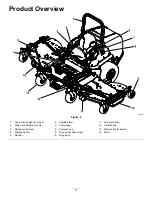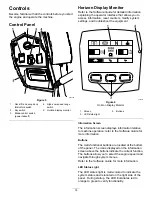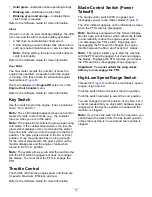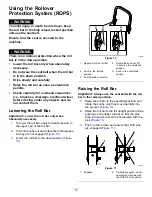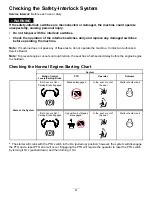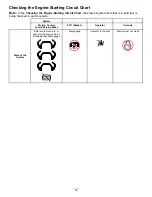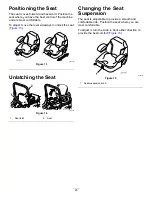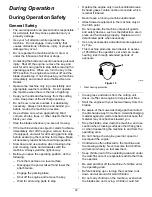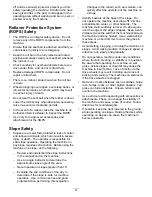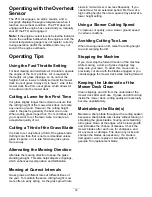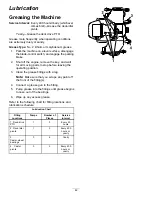
off and be seriously injured or prevent you from
safely operating the machine. Children who have
been given rides in the past could appear in the
operating area without warning and be run over or
backed over by the machine.
Rollover Protection System
(ROPS) Safety
•
The ROPS is an integral safety device. Do not
remove any of the ROPS components from the
machine.
•
Ensure that the seat belt is attached and that you
can release it quickly in an emergency.
•
Keep the roll bar in the fully raised and locked
position and always wear your seat belt whenever
the roll bar is up.
•
Check carefully for overhead objects before you
drive under them, and do not contact them.
•
Replace damaged ROPS components. Do not
repair or alter them.
•
There is no rollover protection when the roll bar
is down.
•
Wheels dropping over edges, over steep banks, or
into water can cause a rollover, which may result
in serious injury or death.
•
Do not wear the seat belt when the roll bar is down.
•
Lower the roll bar only when absolutely necessary;
raise it as soon as clearance permits.
•
In the event of a rollover, take the machine to an
Authorized Service Dealer to inspect the ROPS.
•
Use only Toro approved accessories and
attachments for the ROPS.
Slope Safety
•
Slopes are a major factor related to loss of control
and rollover accidents, which can result in severe
injury or death. The operator is responsible for
safe slope operation. Operating the machine on
any slope requires extra caution. Before using the
machine on a slope, do the following:
– Review and understand the slope instructions
in the manual and on the machine.
– Use an angle indicator to determine the
approximate slope angle of the area.
– Never operate on slopes greater than 15°.
– Evaluate the site conditions of the day to
determine if the slope is safe for machine
operation. Use common sense and good
judgment when performing this evaluation.
Changes in the terrain, such as moisture, can
quickly affect the operation of the machine on
a slope.
•
Identify hazards at the base of the slope. Do
not operate the machine near drop-offs, ditches,
embankments, water, or other hazards. The
machine could suddenly roll over if a wheel goes
over the edge or the edge collapses. Keep a safe
distance (twice the width of the machine) between
the machine and any hazard. Use a walk-behind
machine or a hand trimmer to mow the grass in
these areas.
•
Avoid starting, stopping, or turning the machine on
slopes. Avoid making sudden changes in speed or
direction; turn slowly and gradually.
•
Do not operate a machine under any conditions
where traction, steering, or stability is in question.
Be aware that operating the machine on wet
grass, across slopes, or downhill may cause the
machine to lose traction. Loss of traction to the
drive wheels may result in sliding and a loss of
braking and steering. The machine can slide even
if the drive wheels are stopped.
•
Remove or mark obstacles such as ditches, holes,
ruts, bumps, rocks, or other hidden hazards. Tall
grass can hide obstacles. Uneven terrain could
overturn the machine.
•
Use extra care while operating with accessories or
attachments. These can change the stability of
the machine and cause a loss of control. Follow
directions for counterweights.
•
If possible, keep the deck lowered to the ground
while operating on slopes. Raising the deck while
operating on slopes can cause the machine to
become unstable.
27

